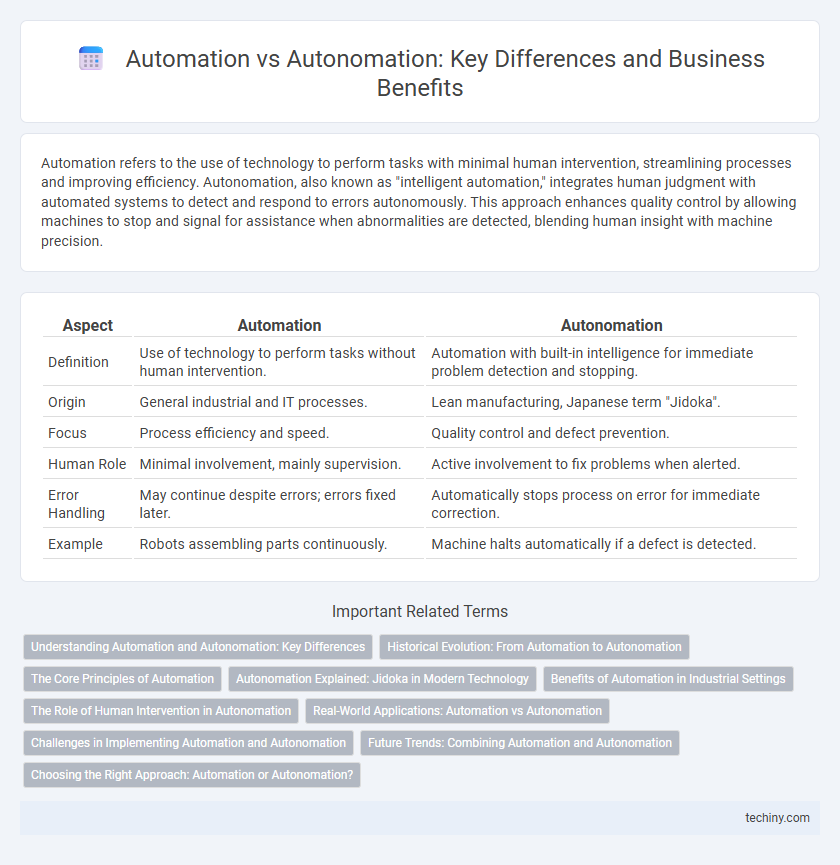Automation refers to the use of technology to perform tasks with minimal human intervention, streamlining processes and improving efficiency. Autonomation, also known as "intelligent automation," integrates human judgment with automated systems to detect and respond to errors autonomously. This approach enhances quality control by allowing machines to stop and signal for assistance when abnormalities are detected, blending human insight with machine precision.
Table of Comparison
| Aspect | Automation | Autonomation |
|---|---|---|
| Definition | Use of technology to perform tasks without human intervention. | Automation with built-in intelligence for immediate problem detection and stopping. |
| Origin | General industrial and IT processes. | Lean manufacturing, Japanese term "Jidoka". |
| Focus | Process efficiency and speed. | Quality control and defect prevention. |
| Human Role | Minimal involvement, mainly supervision. | Active involvement to fix problems when alerted. |
| Error Handling | May continue despite errors; errors fixed later. | Automatically stops process on error for immediate correction. |
| Example | Robots assembling parts continuously. | Machine halts automatically if a defect is detected. |
Understanding Automation and Autonomation: Key Differences
Automation refers to the use of technology to perform tasks without human intervention, enhancing efficiency and consistency across processes. Autonomation, or "jidoka," integrates human intelligence with machines, enabling systems to detect defects and stop automatically for quality control. The key difference lies in automation focusing solely on mechanizing tasks, while autonomation combines automation with immediate human-like decision-making to prevent errors.
Historical Evolution: From Automation to Autonomation
The historical evolution from automation to autonomation marks a significant shift in manufacturing philosophy, emphasizing machines equipped with self-monitoring and error-detection capabilities rather than mere mechanization. Early automation centralized tasks to increase throughput, while autonomation, pioneered by Toyota's jidoka principle, integrates intelligent automation that halts processes upon detecting abnormalities. This advancement reduces defects and empowers human oversight, aligning technological innovation with quality improvement in production systems.
The Core Principles of Automation
Automation centers on using technology to perform repetitive tasks efficiently, whereas autonomation integrates automation with human oversight to detect and address abnormalities instantly. The core principles of automation include consistency, precision, and scalability, ensuring processes run smoothly without human error. Autonomation emphasizes "jidoka," or automation with a human touch, enabling machines to stop themselves when issues arise, enhancing quality control.
Autonomation Explained: Jidoka in Modern Technology
Autonomation, also known as Jidoka, integrates automated machines with human intelligence to detect defects and stop production immediately, ensuring higher quality control in manufacturing processes. This approach contrasts with full automation by emphasizing error prevention and operator intervention rather than complete machine independence. Jidoka's implementation in modern technology enhances efficiency and reliability by combining automation's speed with human oversight for real-time problem solving.
Benefits of Automation in Industrial Settings
Automation in industrial settings enhances operational efficiency by minimizing human error and increasing production speed through advanced robotics and control systems. It significantly reduces labor costs and improves safety by handling hazardous tasks, ensuring consistent product quality. Real-time data collection and analysis within automated processes enable predictive maintenance, reducing downtime and extending equipment lifespan.
The Role of Human Intervention in Autonomation
Autonomation integrates automation with built-in human intervention points to identify and correct errors immediately, ensuring quality control throughout production. Unlike full automation, autonomation relies on operator engagement to monitor machines and stop processes when abnormalities arise, reducing defects and downtime. This human-machine collaboration enhances efficiency by combining precise machinery with human judgment and problem-solving skills.
Real-World Applications: Automation vs Autonomation
Automation streamlines repetitive tasks through pre-programmed systems, widely used in manufacturing assembly lines and data processing to increase efficiency and reduce human error. Autonomation, or "jidoka," integrates human judgment by enabling machines to detect defects and halt operations, enhancing quality control in industries like automotive production and electronics manufacturing. Real-world applications demonstrate automation's strength in throughput optimization, while autonomation excels in maintaining product quality and preventing defective output.
Challenges in Implementing Automation and Autonomation
Implementing automation faces challenges such as high initial costs, integration complexity with existing systems, and the need for skilled personnel to manage advanced technologies. Autonomation, while reducing manual oversight, presents difficulties in defining clear exception-handling protocols and maintaining system flexibility to adapt to unpredictable conditions. Both approaches require continuous monitoring and adjustments to ensure efficiency, accuracy, and alignment with operational goals.
Future Trends: Combining Automation and Autonomation
Future trends in manufacturing prioritize the integration of automation and autonomation, leveraging the precision of robotic systems with the intelligent decision-making capabilities of autonomated machines. Combining real-time data analytics, AI-driven predictive maintenance, and autonomous quality control enhances operational efficiency and reduces downtime significantly. This hybrid approach enables smart factories to adapt swiftly to changing conditions, driving innovation and productivity in Industry 4.0 environments.
Choosing the Right Approach: Automation or Autonomation?
Choosing the right approach between automation and autonomation depends on the nature of the task and desired control levels; automation fully automates processes using machines and software to increase efficiency, while autonomation integrates human oversight with machine assistance to detect and address errors in real-time. Manufacturing industries benefit from autonomation through enhanced quality control by empowering operators to halt production when abnormalities are detected, whereas automation suits repetitive, high-volume tasks requiring minimal human intervention. Evaluating factors such as process complexity, error tolerance, and workforce involvement helps determine whether a fully automated system or an autonomation approach aligns better with operational goals.
Automation vs Autonomation Infographic

 techiny.com
techiny.com